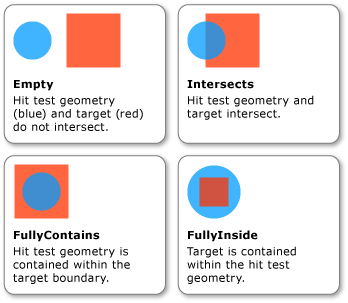Procedura: eseguire un hit test utilizzando la geometria come parametro
In questo esempio viene illustrato come eseguire un hit test su un oggetto visivo usando un Geometry oggetto come parametro di hit test.
Esempio
Nell'esempio seguente viene illustrato come configurare un hit test usando GeometryHitTestParameters per il HitTest metodo . Il Point valore passato al OnMouseDown metodo viene usato per creare un Geometry oggetto per espandere l'intervallo dell'hit test.
// Respond to the mouse button down event by setting up a hit test results callback.
private void OnMouseDown(object sender, MouseButtonEventArgs e)
{
// Retrieve the coordinate of the mouse position.
Point pt = e.GetPosition((UIElement)sender);
// Expand the hit test area by creating a geometry centered on the hit test point.
EllipseGeometry expandedHitTestArea = new EllipseGeometry(pt, 10.0, 10.0);
// Clear the contents of the list used for hit test results.
hitResultsList.Clear();
// Set up a callback to receive the hit test result enumeration.
VisualTreeHelper.HitTest(myControl, null,
new HitTestResultCallback(MyHitTestResultCallback),
new GeometryHitTestParameters(expandedHitTestArea));
// Perform actions on the hit test results list.
if (hitResultsList.Count > 0)
{
ProcessHitTestResultsList();
}
}
' Respond to the mouse button down event by setting up a hit test results callback.
Private Overloads Sub OnMouseDown(ByVal sender As Object, ByVal e As MouseButtonEventArgs)
' Retrieve the coordinate of the mouse position.
Dim pt As Point = e.GetPosition(CType(sender, UIElement))
' Expand the hit test area by creating a geometry centered on the hit test point.
Dim expandedHitTestArea As New EllipseGeometry(pt, 10.0, 10.0)
' Clear the contents of the list used for hit test results.
hitResultsList.Clear()
' Set up a callback to receive the hit test result enumeration.
VisualTreeHelper.HitTest(myControl, Nothing, New HitTestResultCallback(AddressOf MyHitTestResultCallback), New GeometryHitTestParameters(expandedHitTestArea))
' Perform actions on the hit test results list.
If hitResultsList.Count > 0 Then
ProcessHitTestResultsList()
End If
End Sub
La IntersectionDetail proprietà di GeometryHitTestResult fornisce informazioni sui risultati di un hit test che usa come Geometry parametro di hit test. La figura seguente mostra la relazione tra la geometria di hit test (cerchio blu) e il contenuto sottoposto a rendering dell'oggetto visivo di destinazione (quadrato rosso).

Nell'esempio seguente viene illustrato come implementare un callback di hit test quando un Geometry oggetto viene usato come parametro di hit test. Il result parametro viene eseguito il cast a un GeometryHitTestResult oggetto per recuperare il valore della IntersectionDetail proprietà . Il valore della proprietà consente di determinare se il Geometry parametro hit test è completamente o parzialmente contenuto all'interno del contenuto sottoposto a rendering della destinazione di hit test. In questo caso, il codice di esempio aggiunge i risultati dell'hit test all'elenco solo per gli oggetti visivi completamente contenuti all'interno del limite della destinazione.
// Return the result of the hit test to the callback.
public HitTestResultBehavior MyHitTestResultCallback(HitTestResult result)
{
// Retrieve the results of the hit test.
IntersectionDetail intersectionDetail = ((GeometryHitTestResult)result).IntersectionDetail;
switch (intersectionDetail)
{
case IntersectionDetail.FullyContains:
// Add the hit test result to the list that will be processed after the enumeration.
hitResultsList.Add(result.VisualHit);
return HitTestResultBehavior.Continue;
case IntersectionDetail.Intersects:
// Set the behavior to return visuals at all z-order levels.
return HitTestResultBehavior.Continue;
case IntersectionDetail.FullyInside:
// Set the behavior to return visuals at all z-order levels.
return HitTestResultBehavior.Continue;
default:
return HitTestResultBehavior.Stop;
}
}
' Return the result of the hit test to the callback.
Public Function MyHitTestResultCallback(ByVal result As HitTestResult) As HitTestResultBehavior
' Retrieve the results of the hit test.
Dim intersectionDetail As IntersectionDetail = (CType(result, GeometryHitTestResult)).IntersectionDetail
Select Case intersectionDetail
Case IntersectionDetail.FullyContains
' Add the hit test result to the list that will be processed after the enumeration.
hitResultsList.Add(result.VisualHit)
Return HitTestResultBehavior.Continue
Case IntersectionDetail.Intersects
' Set the behavior to return visuals at all z-order levels.
Return HitTestResultBehavior.Continue
Case IntersectionDetail.FullyInside
' Set the behavior to return visuals at all z-order levels.
Return HitTestResultBehavior.Continue
Case Else
Return HitTestResultBehavior.Stop
End Select
End Function
Nota
Il HitTestResult callback non deve essere chiamato quando il dettaglio dell'intersezione è Empty.
Vedi anche
.NET Desktop feedback
